Riding in to Madison this deceptively chilly (three layers!) spring day, I noticed something amiss:
 The good old motel sign outside of the erstwhile Lake Park, now slightly misnamed US-34 Motel on the west edge of town seemed a little short. Hey, what's that on the ground in front of it?
The good old motel sign outside of the erstwhile Lake Park, now slightly misnamed US-34 Motel on the west edge of town seemed a little short. Hey, what's that on the ground in front of it?
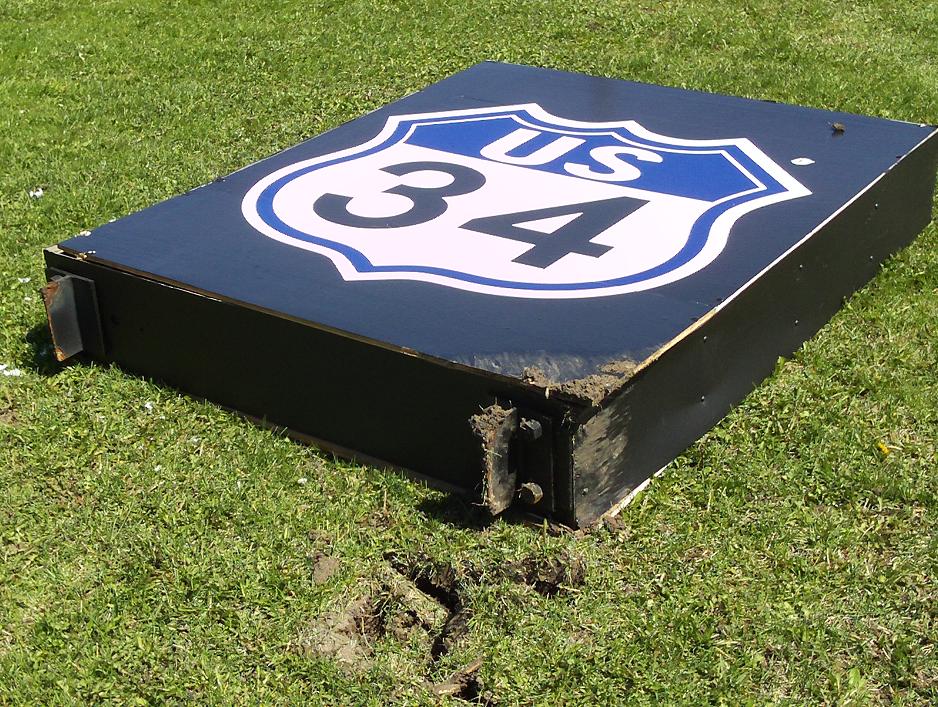 Oh. The top of the sign. Check out that divot.
Oh. The top of the sign. Check out that divot.
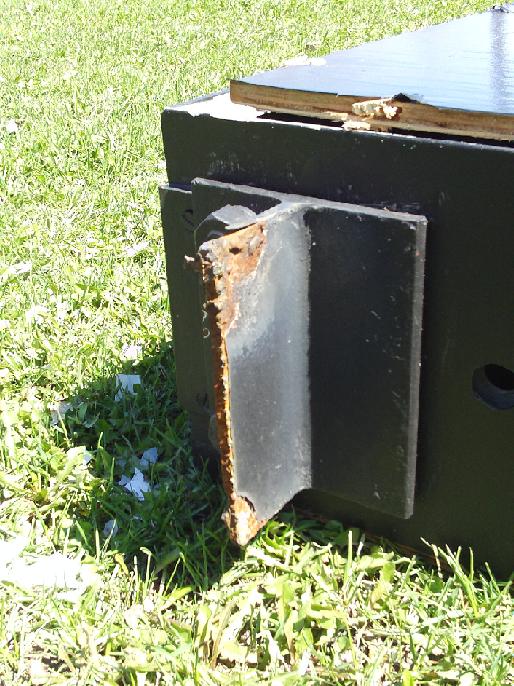 Some reasonably significant steel held that sign in place. That metal (or two old welds?) was no match for 36 hours of sustained winds over 25 mph and gusts into the 50s.
Some reasonably significant steel held that sign in place. That metal (or two old welds?) was no match for 36 hours of sustained winds over 25 mph and gusts into the 50s.
Now grab your slide rule: here's today's trigonomentry problem!
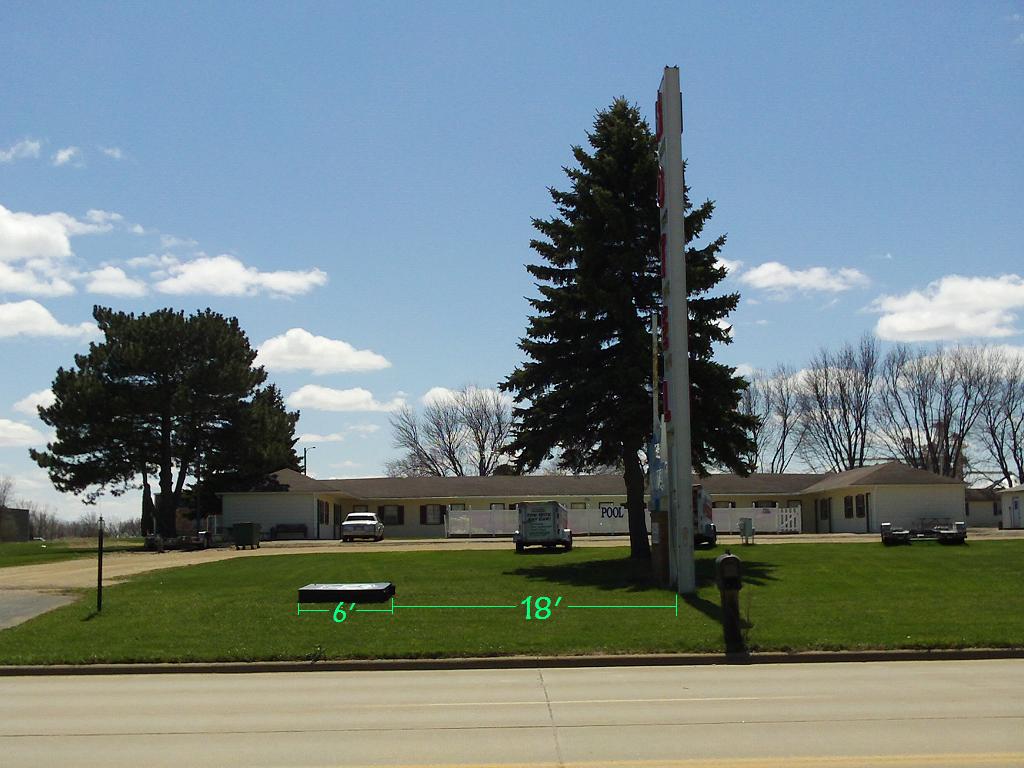 I paced off the distance: that 6-foot sign landed 18 feet from the base of the tower. Can you calculate the sign's horizontal velocity vector when it broke free? (Remember: acceleration due to gravity = 32 ft/sec2.)
I paced off the distance: that 6-foot sign landed 18 feet from the base of the tower. Can you calculate the sign's horizontal velocity vector when it broke free? (Remember: acceleration due to gravity = 32 ft/sec2.)
I chatted with the owner; luckily no one was out playing cricket in the front yard when the sign descended. We both marveled to see what the wind failed to tear loose:
 Vinyl sign, four grommets, and rope: tougher than steel!
Vinyl sign, four grommets, and rope: tougher than steel!
Bonus local pic: The news was happier downtown, where I found some fellas rocking Main Street:
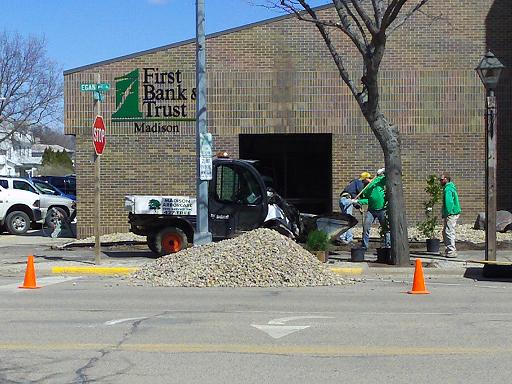 Any job is more fun when you get to use bucket machinery.
Any job is more fun when you get to use bucket machinery.
Back home, my folks' newspaper deilvery box bent but didn't break in the weekend gale:
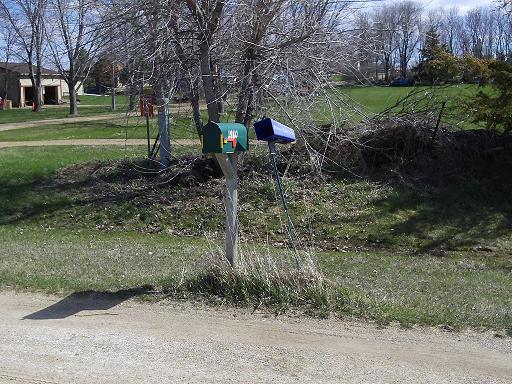 I guess the Madison Daily Leader really is leaning a bit more to the left.
I guess the Madison Daily Leader really is leaning a bit more to the left.

It didn't dawn on me that that's why the paper box was bent - I just tried to straighten it out without much success. I guess it's good that the really important stuff just stayed put. I hadn't noticed it until you mentioned it either. I am super observant - duh. Grandma
Not sure it can be calculated without knowing the height of the sign.
Indeed! Given the diagram, and assuming minimal distorition from my cheap camera, how might we obtain that figure?
We must know the height of the sign to solve this problem. We must also assume that, once the sign broke free, it encountered no air resistance (such as sustained wind continuing to exert horizontal force on it).
Let's assume, based on visual inspection, that the sign fell from a height of 32 ft. On that basis, and with the constraint I noted above, I calculate a horizontal velocity vector of a little less than 13 ft/s on impact. That's about 9 mi/h.
The downward speed component would be around 45 ft/s or 31 mi/h.
With vector addition we would get an actual impact speed of about 47 ft/s or 32 mi/h.
It's the wee-hour time, my calculation skills might be on the wane, so it's entirely possible that I messed this up.
I continue to marvel at how spoiled we are here in the Midwest. Numerous EF3 and EF4 tornadoes recently struck in the Southeast, as we all know. Most of us have seen photos of the damage. I happen to have gone through the most violent part of Hurricane Andrew in 1992 with wind gusts of around 170 mi/h, qualifying that storm as the equivalent of an EF4 tornado that continued for the better part of two hours. After that storm, the damage looked quite a lot like the photos of the ruins in Alabama, but in the case of Andrew, it went on for mile after mile after mile.
One of the more remarkable effects was the dismantling of a concrete and steel warehouse by the force of the wind alone. Of course, one may argue that the original building contractors used too much sand in the mortar between the cinder blocks ...
As I said, we're spoiled up here.
P.S. That sort of wind really does sound like a freight train.
9 mph: That's close to what I got! Every physics book I've used says disregard air resistance... although it was air resistance that made this problem possible in the first place. :-)
Now a really bad math problem: if folks down south faced a 170 mph tornado for under an hour, and if we faced 30-40 mph winds for 36 hours, did we face the equivalent of 7 tornadoes' worth of wind?
If an apple a day keeps the doctor away, will 100 apples a day keep 100 doctors away?
I am not sure that any of the above is completely correct.
If you scale the height of the base of the sign in proportion to the 18 or 24 feet on the ground, it probably is about 32 feet above the ground. The vertical speed would be about 45 feet per second when sign hit ground or as Stan indicates about 31 mph. The average horizontal velocity would be about 13 ft per second since the sign starts at zero velocity. Using F=MA, etc one could calculate the acceleration which might be about 9 ft per second per second. That could be used to measure force on the sign, but I don't think anything in those calculations can be used to indicate actual wind speed. That would require knowing the mass of the sign, the area of the sign, and knowing the conversion between wind speed and pressure per sq in or sq ft of sign, etc.
and then working backwards to wind speed from the acceleration calculated above.
Information on wind speed and resulting force on unit area:
http://www.convert-me.com/en/bb/viewtopic.php?t=1047